Few people know that potatoes were once a wild plant that took five thousand years to domesticate successfully. Today, it is a traditional cultivated vegetable grown in almost every garden and allotment.
The Agatha potato variety wins hearts not only with its taste—making it a popular choice for crisps—but also with its high yield. Although not originally bred in Europe, this variety has adapted well to various European climates.
Table of contents
Characteristics of the Agatha Potato Variety
Let’s take a closer look at the features of this variety.
Origin and Development
The Agatha potato variety comes from the Netherlands. Dutch breeders developed it to be high-yielding and early-maturing. In Europe, it has gained popularity among both home gardeners and commercial farmers.
While not yet listed in some national seed registries, its popularity continues to grow due to its adaptability and reliability.
Historical note. The potato originates from South America. For over 10,000 years, indigenous people attempted to cultivate wild potatoes with little success. It took another 5,000 years before successful domestication occurred in Peru, where potatoes were even worshipped. Today, Peruvian markets offer up to 1,000 potato varieties, sold both raw and as ready-to-eat dishes.
Description and Appearance
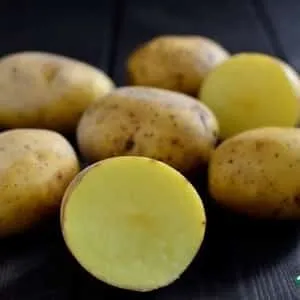 The tubers are oval, slightly elongated, with small eyes. The average weight is 80–130 g. With a starch content of no more than 14%, the potatoes hold their shape well when cooked. The skin is smooth and pale yellow, while the flesh is firm and yellowish with a slightly sweet taste.
The tubers are oval, slightly elongated, with small eyes. The average weight is 80–130 g. With a starch content of no more than 14%, the potatoes hold their shape well when cooked. The skin is smooth and pale yellow, while the flesh is firm and yellowish with a slightly sweet taste.
The photo shows Agatha potatoes.
This variety is excellent for long-term storage and transport. To preserve quality, store in a cool, dry place.
Agatha potatoes are versatile in cooking, perfect for frying, mashing, baking, crisps, and frozen vegetable mixes.
Note! Many crisp manufacturers prefer this variety for its texture and flavour.
Plant Characteristics
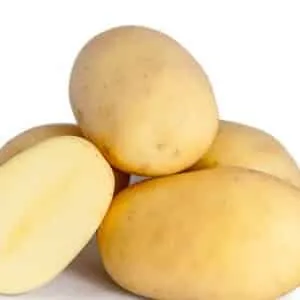 This is an early-maturing table variety, with tubers ready for harvest in 80–85 days, though first digging can be done as early as 50–55 days.
This is an early-maturing table variety, with tubers ready for harvest in 80–85 days, though first digging can be done as early as 50–55 days.
The bushes are compact, moderately leafy, with small dark green leaves and large white flowers. The root system is strong, ensuring uniform tuber growth with minimal small potatoes.
Disease resistance is above average—resistant to Alternaria, Verticillium wilt, and potato scab, but susceptible to late blight and Fusarium wilt.
Yield
This variety is highly productive, yielding up to 40 tonnes per hectare. Each plant produces 10–15 tubers, which store well until spring. For optimal growth, plant in well-fertilised soil, though it can also thrive in heavy clay soils.
Growing Agatha Potatoes
One advantage of Agatha is its suitability for early planting. Seed potatoes can be sown once soil temperatures reach +10°C.
Planting Time, Scheme, and Guidelines
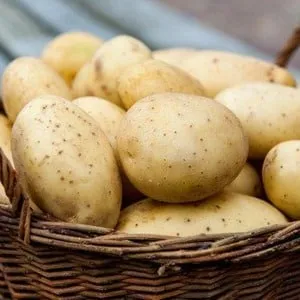 Prepare seed potatoes a month before planting by selecting healthy, undamaged tubers. Place them in boxes in two layers and expose to light for sprouting at around +15°C.
Prepare seed potatoes a month before planting by selecting healthy, undamaged tubers. Place them in boxes in two layers and expose to light for sprouting at around +15°C.
Planting is ready when sprouts reach 1.5 cm and turn pinkish. A day before planting, treat tubers with a growth stimulator like "Epibrassinolide" and an antifungal agent like "Tebuconazole".
Prepare the soil two weeks in advance by digging in compost and wood ash. Plant tubers 10 cm deep, 30 cm apart, with 70 cm between rows. Place tubers sprout-side up, cover with soil, and water lightly.
Note! Seed potatoes should not exceed 100 g in weight.
Ongoing Care
Agatha potatoes require standard care: fertile soil and proper watering, especially in dry spells. Drip irrigation is ideal, ensuring moisture reaches roots without waterlogging.
Note! Excess moisture increases fungal disease risks.
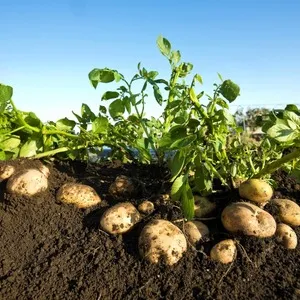 After watering, loosen soil to improve aeration, aiding root development.
After watering, loosen soil to improve aeration, aiding root development.
Weed regularly to prevent nutrient competition and disease spread.
Hilling is done three times before flowering. Mounding soil around stems encourages additional root growth. Mulch with straw to suppress weeds and deter pests.
Fertilisation boosts yields. Alternate mineral and organic fertilisers.
Note! Fertile soil and proper feeding are key to high yields.
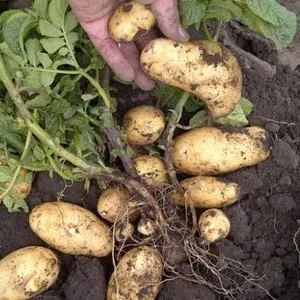 Use nitrogen-rich fertilisers early for foliage growth.
Use nitrogen-rich fertilisers early for foliage growth.
During flowering, apply organic fertilisers like diluted poultry manure (1:10) or compost tea with wood ash.
At tuber formation, focus on potassium and phosphorus. Foliar feeding with a superphosphate solution (100 g per 10 L water) is effective.
Important! Foliar sprays provide immediate nutrient absorption.
Recommended mineral fertilisers include "Osmocote", "Compo", and "YaraMila".
Challenges and Considerations
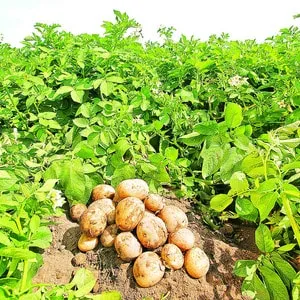 Follow crop rotation rules. Ideal predecessors are cucumbers and onions; avoid planting after peppers, aubergines, or tomatoes.
Follow crop rotation rules. Ideal predecessors are cucumbers and onions; avoid planting after peppers, aubergines, or tomatoes.
Do not plant these crops nearby—shared diseases can spread rapidly.
Avoid excessive nitrogen, which leads to nitrate accumulation in tubers.
Diseases and Pests
Agatha is vulnerable to Fusarium wilt and late blight. Pests like wireworms and Colorado beetles also pose threats.
Fusarium and late blight are fungal diseases that can destroy up to 70% of crops. Prevent with manganese solution sprays or fungicides like "Revus" or "Infinito".
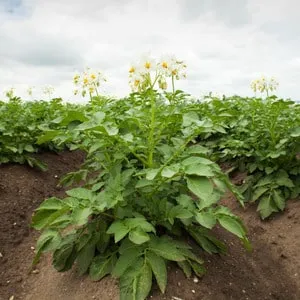 Wireworms and Colorado beetles are major pests. Wireworms damage roots; deter them with buried garlic or mustard plants.
Wireworms and Colorado beetles are major pests. Wireworms damage roots; deter them with buried garlic or mustard plants.
Colorado beetles are easily spotted. Handpick adults and larvae, or use insecticides like "Mospilan" or "Decis".
Harvesting, Storage, and Uses
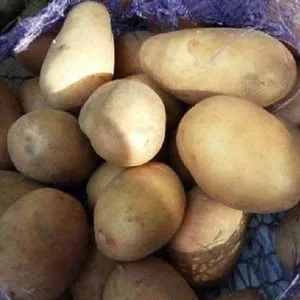 Main harvest occurs in August, though early digging starts in mid-July. Cut foliage 10 cm above ground 2–3 days before harvesting. Dry tubers in the field or under shelter if rain is expected.
Main harvest occurs in August, though early digging starts in mid-July. Cut foliage 10 cm above ground 2–3 days before harvesting. Dry tubers in the field or under shelter if rain is expected.
Store in cool, dry conditions for long-term preservation.
Agatha is grown both in home gardens and commercially. It stores well, with 93% of tubers retaining marketable quality. Tubers are uniformly large.
Ideal for fresh cooking and processed foods, including crisps and pre-made dishes.
Pros and Cons
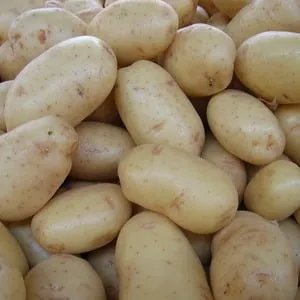 Beyond excellent taste, this variety offers:
Beyond excellent taste, this variety offers:
- Adaptability to various European climates;
- Low maintenance;
- High yields;
- Versatile culinary uses;
- Long shelf life;
- Suitability for commercial farming;
- Attractive appearance and marketability.
Drawbacks include susceptibility to Fusarium wilt and late blight.
Best Growing Regions in Europe
Highest yields (30–40 tonnes/ha) are achieved in:
- Central Europe;
- Northern France;
- Southern Germany;
- Benelux countries.
Grower Reviews
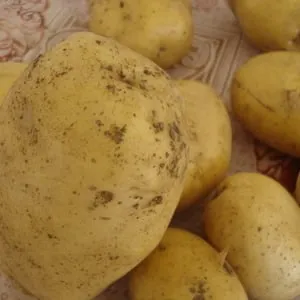 Here’s what growers say about Agatha potatoes. Most feedback is positive.
Here’s what growers say about Agatha potatoes. Most feedback is positive.
Thomas, Belgium: “I’ve grown Agatha on a hectare for two years. Compost is applied in autumn. Yields are excellent—I harvest in late July, keeping some rows for seed. The taste is unique, slightly sweet. Low starch means they hold shape when cooked. Perfect for mash!”.
Sophie, France: “What stands out is how easy they are to grow. My plants rarely get sick. I pre-treat against Colorado beetles with insecticides and plant marigolds between rows. The potatoes are delicious, especially roasted or in pies.”.
Conclusion
Many growers favour the Agatha potato for its high yields (up to 40 tonnes/ha), disease resistance, early maturity, and straightforward cultivation. Commercial farmers also appreciate its long shelf life, allowing enjoyment of home-grown potatoes well into spring.







